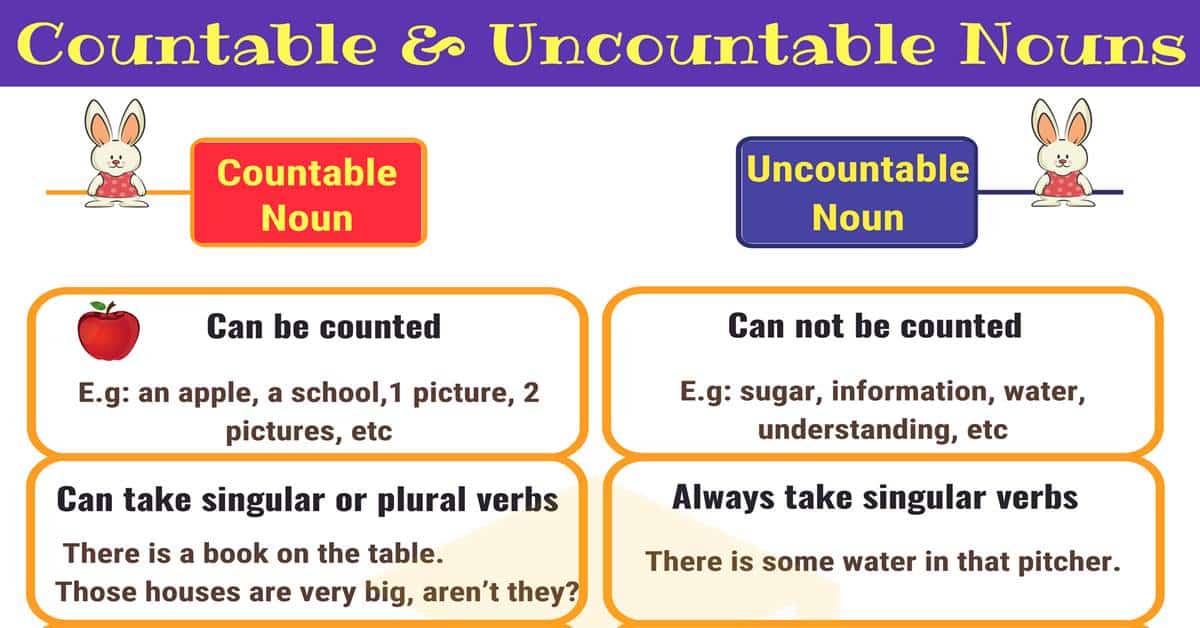COUNT NOUNS AND NON-COUNT NOUNS
Count and non-count nouns vary from language to language. In some languages, there are no count nouns (e.g., Japanese). In addition, some nouns that are noncount in English may be countable in other languages (e.g., hair or information).
Errors with count and noncount nouns can result in errors with article usage and with subject verb agreement.
Count Nouns
What is a count noun?
Count nouns can be separated into individual units and counted. They usually have both a singular and a plural form. Most English nouns are count nouns.
- one phone, two phones
- one dog, two dogs
- one shirt, two shirts
However, a few countable nouns only have a plural form in English. Here are a few examples:
- clothes
- pants
- jeans
- shorts
- pajamas
These are often used with some sort of quantifier, or quantity word, to show how they are counted (e.g., "a pair of" pants, "two pairs of" pants, "some" pants).
How are count nouns made plural?
Count nouns are usually made plural by adding an "-s" or an "-es."
- one boy, two boys
- one folder, two folders
- one box, two boxes
- one church, two churches
If the noun ends in "-y," change the "-y" to "-ies" to make it plural.
- one family, two families
- one party, two parties
However, if a vowel precedes the "-y," add just an "-s" to make it plural.
- one toy, two toys
- one donkey, two donkeys
If the noun ends in "-o," add "-es" to make it plural.
- one potato, two potatoes
- one tomato, two tomatoes
If the noun ends in "-f" or "-fe," change the "-f" to a "-v" and add "-es."
- one thief, two thieves
- one hoof, two hooves
Some count nouns have irregular plural forms. Many of these forms come from earlier forms of English.
- one foot, two feet
- one person, two people
- one tooth, two teeth
- one criterion, two criteria
When unsure of the plural form, please consult the dictionary. An English learner’s dictionary (such as Merriam-Webster, Cambridge, Oxford, or Longman) may be the most useful.
Important: Singular count nouns must have a word in the determiner slot. This could be an article, a pronoun, or a possessive noun (i.e., "a," "an," "the," "this," or a possessive noun).
Non-count Nouns
What is a noncount noun?
Noncount (or uncountable) nouns exist as masses or abstract quantities that cannot be counted. They have no plural form. Although most English nouns are count nouns, noncount nouns frequently occur in academic writing.
Here are some common categories of noncount nouns. Like all things in English (and language in general), there may be exceptions.
A mass: work, equipment, homework, money, transportation, clothing, luggage, jewelry, traffic
A natural substance: air, ice, water, fire, wood, blood, hair, gold, silver
Food: milk, rice, coffee, bread, sugar, meat, water
An abstract concept: advice, happiness, health, education, research, knowledge, information, time
A game: soccer, tennis, basketball, hockey, football, chess, checkers
A disease: diabetes, measles, polio, influenza, malaria, hypothyroidism, arthritis
A subject of study: economics, physics, astronomy, biology, history, statistics
A language: Arabic, Chinese, Spanish, English
An activity (in the "-ing" form): swimming, dancing, reading, smoking, drinking, studying
Important: Noncount nouns do not use the indefinite articles "a" or "an." They can, however, use the definite article "the" if what is being referred to is specific. They can also use no article if what is being referred to is general (generic) or nonspecific.
Activity



Comentarios
Publicar un comentario